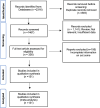Resistance of Vibrio cholera to antibiotics that inhibit cell wall synthesis: A systematic review and meta-analysis
- PMID: 37021056
- PMCID: PMC10069679
- DOI: 10.3389/fphar.2023.1027277
Resistance of Vibrio cholera to antibiotics that inhibit cell wall synthesis: A systematic review and meta-analysis
Abstract
Objective: Cholera is a challenging ancient disease caused by Vibrio cholera (V. cholera). Antibiotics that prevent cell wall synthesis are among the first known antibiotic groups. Due to its high consumption, V. cholera has developed resistance to the majority of antibiotics in this class. Resistance to recommended antibiotics for the treatment of V. cholera has also increased. In light of the decrease in consumption of certain antibiotics in this group that inhibit cell wall synthesis and the implementation of new antibiotics, it is necessary to determine the antibiotic resistance pattern of V. cholera and to employ the most effective treatment antibiotic. Method: An comprehensive systematic search for relevant articles was conducted in PubMed, Web of Science, Scopus, and EMBASE through October 2020. Stata version 17.1 utilized the Metaprop package to execute a Freeman-Tukey double arcsine transformation in order to estimate weighted pooled proportions. Results: A total of 131 articles were included in the meta-analysis. Ampicillin was the most investigated antibiotic. The prevalence of antibiotic resistance was in order aztreonam (0%), cefepime (0%), imipenem (0%), meropenem (3%), fosfomycin (4%), ceftazidime (5%), cephalothin (7%), augmentin (8%), cefalexin (8%), ceftriaxone (9%), cefuroxime (9%), cefotaxime (15%), cefixime (37%), amoxicillin (42%), penicillin (44%), ampicillin (48%), cefoxitin (50%), cefamandole (56%), polymyxin-B (77%), carbenicillin (95%) respectively. Discussion: Aztreonam, cefepime, and imipenem are the most efficient V. cholera cell wall synthesis inhibitors. There has been an increase in resistance to antibiotics such as cephalothin, ceftriaxone, amoxicillin, and meropenem. Over the years, resistance to penicillin, ceftazidime, and cefotaxime, has decreased.
Keywords: V. cholera; Vibrio cholera; antibiotic resistance; meta-analysis; resistance.
Copyright © 2023 Nateghizad, Sajadi, Shivaee, Shirazi, Sharifian, Tadi and Amini.
Conflict of interest statement
The authors declare that the research was conducted in the absence of any commercial or financial relationships that could be construed as a potential conflict of interest.
Figures


Similar articles
-
A systematic review and meta-analysis on the epidemiology of antibiotic resistance of Vibrio cholerae in Iran.Ann Ig. 2019 May-Jun;31(3):279-290. doi: 10.7416/ai.2019.229. Ann Ig. 2019. PMID: 31069372
-
Prevalence of Antibiotic Resistance of Haemophilus Influenzae in Iran- A Meta-Analysis.Iran J Otorhinolaryngol. 2019 Nov;31(107):349-357. doi: 10.22038/ijorl.2019.34363.2137. Iran J Otorhinolaryngol. 2019. PMID: 31857979 Free PMC article.
-
Antibiotics resistance in El Tor Vibrio cholerae 01 isolated during cholera outbreaks in Mozambique from 2012 to 2015.PLoS One. 2017 Aug 8;12(8):e0181496. doi: 10.1371/journal.pone.0181496. eCollection 2017. PLoS One. 2017. PMID: 28792540 Free PMC article.
-
The prevalence of multiple drug resistance Escherichia coli and Klebsiella pneumoniae isolated from patients with urinary tract infections.J Clin Lab Anal. 2022 Sep;36(9):e24619. doi: 10.1002/jcla.24619. Epub 2022 Jul 23. J Clin Lab Anal. 2022. PMID: 35870190 Free PMC article.
-
Antibiotic Resistance of Uropathogenic Escherichia coli (UPEC) among Iranian Pediatrics: A Systematic Review and Meta-Analysis.Iran J Public Health. 2024 Mar;53(3):508-523. doi: 10.18502/ijph.v53i3.15133. Iran J Public Health. 2024. PMID: 38919304 Free PMC article. Review.
Cited by
-
Spotlight on the epidemiology and antimicrobial susceptibility profiles of Vibrio species in the MENA region, 2000-2023.Future Microbiol. 2024;19(15):1333-1353. doi: 10.1080/17460913.2024.2392460. Epub 2024 Sep 4. Future Microbiol. 2024. PMID: 39229784 Review.
-
Frontiers in superbug management: innovating approaches to combat antimicrobial resistance.Arch Microbiol. 2025 Feb 14;207(3):60. doi: 10.1007/s00203-025-04262-x. Arch Microbiol. 2025. PMID: 39953143 Review.
-
Unveiling the Anti-Cholera and Active Diabetic Renoprotective Compounds of Maqian Essential Oil: A Computational and Molecular Dynamics Study.Molecules. 2023 Dec 5;28(24):7954. doi: 10.3390/molecules28247954. Molecules. 2023. PMID: 38138443 Free PMC article.
-
Vibrio cholerae O1 and Escherichia coli O157:H7 from drinking water and wastewater in Addis Ababa, Ethiopia.BMC Microbiol. 2024 Jun 20;24(1):219. doi: 10.1186/s12866-024-03302-8. BMC Microbiol. 2024. PMID: 38902619 Free PMC article.
References
-
- Abera B., Bezabih B., Dessie A. (2010). Antimicrobial suceptibility of V. cholerae in north west, Ethiopia. Ethiop. Med. J. 48, 23–28. - PubMed
-
- AL-Hilu S. A., AL-Mohana A, Jaber Z., Hinthong W. (2019). Molecular epidemiology of antimicrobial resistance and virulence profiles of Escherichia coli, Salmonella spp., and Vibrio spp. isolated from coastal seawater for aquaculture. Antibiotics 11, 1688. 10.3390/antibiotics11121688 - DOI - PMC - PubMed
Publication types
LinkOut - more resources
Full Text Sources

